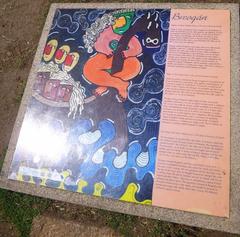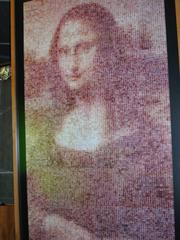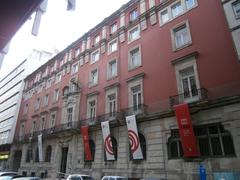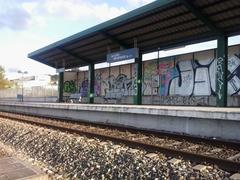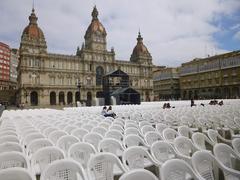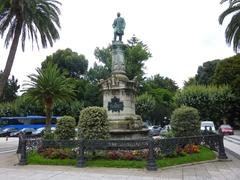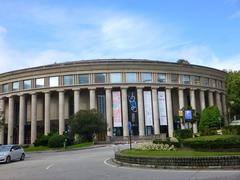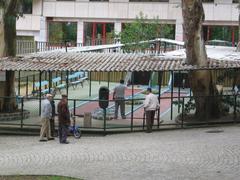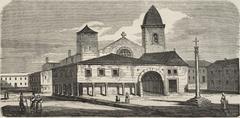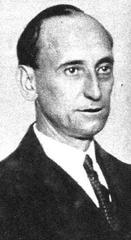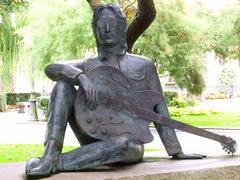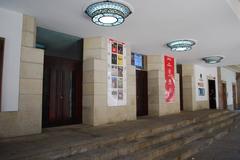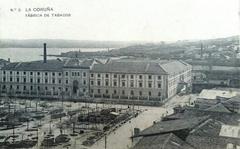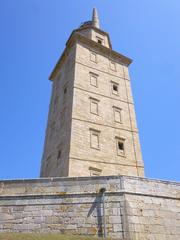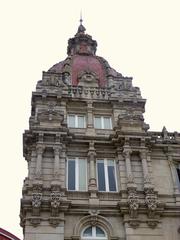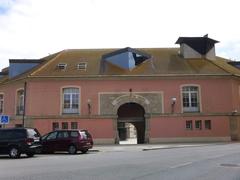Iglesia de Santiago: Visiting Hours, Tickets, and Historical Sites in A Coruña
Date: 03/07/2025
Introduction
The Iglesia de Santiago, nestled in the heart of A Coruña’s medieval quarter, stands as one of Galicia’s most treasured landmarks. This Romanesque gem not only offers a window into the region’s architectural and spiritual heritage but also serves as a pivotal stop along the English Way (Camino Inglés) of the famed Camino de Santiago pilgrimage route. With its origins in the 12th century, the church showcases an evolution from robust Romanesque forms to graceful Gothic additions, mirroring centuries of religious and cultural development. Today, visitors are drawn by its intricately carved portals, the revered 13th-century statue of Saint James, and a vibrant schedule of religious and cultural events. This guide provides comprehensive information on visiting hours, admission, accessibility, historical context, and tips for making the most of your visit in A Coruña (Spotting History; Galicia Guide; Turismo de Galicia; Xunta de Galicia).
Table of Contents
- Introduction
- Historical Overview
- Visiting Information
- Frequently Asked Questions (FAQ)
- Conclusion
- Plan Your Visit and Stay Connected
- References
Historical Overview
Romanesque Foundations and Early Construction
Founded in the 12th century, the Iglesia de Santiago is a prime example of Romanesque architecture in Galicia. Its robust granite walls, semicircular arches, and compact design reflect both the defensive needs and spiritual ambitions of medieval A Coruña. The church’s location near the ancient Roman walls and central squares placed it at the heart of civic life and pilgrimage activity (Spotting History; Galicia Guide).
Gothic Modifications and Pilgrimage Connections
In the 14th and 15th centuries, the church underwent significant Gothic enhancements, including the addition of pointed arches, ribbed vaults, and a prominent rose window. These changes coincided with the flourishing of the Camino de Santiago pilgrimage, with the church offering spiritual rest and support for travelers—especially those arriving from northern Europe along the English Way (Xunta de Galicia).
Artistic and Architectural Features
Main Façade: The western façade is adorned with a Romanesque portal featuring multiple archivolts with geometric and vegetal motifs. The tympanum depicts St. James as a pilgrim, a nod to the church’s dedication and role in the pilgrimage tradition.
Interior: The nave, originally constructed with three aisles and semicircular apses, was remodeled into a single nave with a wooden gabled roof. The Romanesque apse, with its sculpted capitals, and the 13th-century statue of Saint James are highlights.
Artworks and Details: Noteworthy elements include medieval frescoes, capitals carved with biblical and local motifs such as scallop shells, a 17th-century pulpit, Roman altars from the Tower of Hercules, and rare sculptures of the Virgin Mary. The corbels and capitals throughout display a blend of biblical iconography and Galician flora and fauna (Turismo de Galicia).
Role in Medieval and Modern A Coruña
Historically, the Iglesia de Santiago was the principal church and a civic meeting place until the late 15th century. Its position as a stop for English Way pilgrims arriving by sea cemented its reputation as a spiritual and cultural hub. Today, it remains central to community life, hosting major celebrations like the Feast of St. James on July 25th, as well as concerts and exhibitions.
Visiting Information
Hours and Admission
- Monday to Friday: 10:00 am – 1:30 pm & 5:00 pm – 7:30 pm
- Saturday: 11:00 am – 1:30 pm & from 5:00 pm until the end of evening Mass
- Mass Times: Monday–Saturday at 8:00 pm; Sundays and public holidays at 12:30 pm & 8:00 pm
Note: Hours may vary during religious events and holidays. Confirm before your visit by calling +34 981 205 696 or checking the official tourism website.
- Admission: Free. Donations are appreciated and support ongoing preservation.
- Guided Tours: Available through local tourism offices or as part of walking tours; some tours may require a fee.
Accessibility
The church is mostly accessible, with ramps at the main entrance. Due to the historic nature of the building, some areas have uneven flooring or steps.
Guided Tours and Special Events
Guided visits provide deeper insight into the church’s history and art. The annual Feast of St. James (July 25th) is a highlight, drawing both locals and pilgrims for vibrant processions and special Masses.
Travel Tips
- Best Times: Weekday mornings for a quieter experience; July for festive celebrations.
- Photography: Allowed (no flash during services).
- Language: Signage is in Spanish and Galician; some staff speak English.
- Transport: Church is located in the Old Town, easily accessible by foot or public transport. Parking is limited.
Nearby Attractions
- Colegiata de Santa María del Campo: Another Romanesque church nearby.
- Plaza de María Pita: Central square with City Hall and a monument to María Pita.
- Torre de Hércules: UNESCO-listed lighthouse, about 2 km away.
- Local Museums: Museo Histórico Militar and Casa Museo Emilia Pardo Bazán.
Frequently Asked Questions (FAQ)
Q: What are the Iglesia de Santiago visiting hours?
A: Monday to Friday, 10:00 am–1:30 pm & 5:00 pm–7:30 pm; Saturday, 11:00 am–1:30 pm & from 5:00 pm until evening Mass. Masses are at 8:00 pm (Mon–Sat) and 12:30 pm/8:00 pm (Sundays/holidays).
Q: Is there an admission fee?
A: Entry is free. Donations are welcome. Guided tours may have a fee.
Q: Are guided tours available?
A: Yes, through local tourism offices or organized walking tours; booking ahead is recommended.
Q: Is the church accessible for people with disabilities?
A: There are ramps at the entrance, but some areas may be less accessible due to historic flooring.
Q: Can I obtain a Camino pilgrim credential here?
A: Yes, the church issues official pilgrim stamps and credentials (Xunta de Galicia).
Conclusion
The Iglesia de Santiago in A Coruña is a vital link to Galicia’s medieval and spiritual heritage. Its enduring Romanesque foundations, Gothic flourishes, and central role in the Camino de Santiago pilgrimage make it a must-visit for travelers, history buffs, and pilgrims alike. With free admission, accessible facilities, and a wealth of nearby attractions, the church is both welcoming and informative for all who wish to engage with A Coruña’s rich past and living traditions. For a deeper exploration, plan your visit around the Feast of St. James or join a guided tour for expert insights.
Plan Your Visit and Stay Connected
For the latest travel updates and event information, download the Audiala app and follow us on social media. Explore related articles on other medieval churches and A Coruña’s historical landmarks, and let Audiala guide you through an unforgettable Galician experience.
Visuals and Resources
- Image suggestion: Iglesia de Santiago façade, alt text: “Iglesia de Santiago A Coruña Romanesque and Gothic façade”
- Interior photo suggestion: Statue of Saint James, alt text: “13th-century statue of Saint James inside Iglesia de Santiago”
- Map recommendation: Highlight the church’s location in A Coruña’s Old Town and nearby attractions
- Virtual tour link: Check Turismo de Galicia’s website for multimedia resources
References
- Iglesia de Santiago A Coruña: Visiting Hours, Tickets, and Historical Overview, 2025, Spotting History (Spotting History)
- Galicia Guide: La Coruña Medieval, 2025, Galicia Guide (Galicia Guide)
- Iglesia de Santiago in A Coruña: Architectural Highlights, Visiting Hours, and Tips for Visitors, 2025, Turismo de Galicia (Turismo de Galicia)
- Iglesia de Santiago in A Coruña: Visiting Hours, Tickets, and Historical Significance, 2025, Xunta de Galicia (Xunta de Galicia)


